What Is Adaptive Equipment… And How To Pay for It
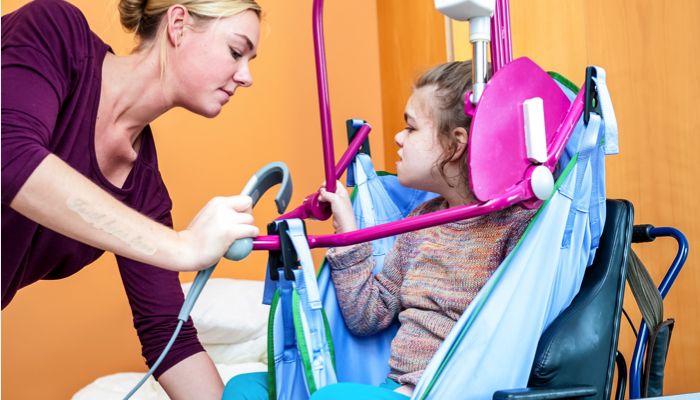
This post may contain affiliate links; please see our terms of use for details.
- Adaptive equipment is any device that improves a person’s ability to complete an activity of daily living.
- For children ages 0–21, adaptive equipment considered medically necessary may be covered by insurance.
- The process of obtaining adaptive equipment is complex and usually requires coordination of the healthcare team, an evaluation, a physician’s prescription, and a letter of medical necessity.
One challenge of being the parent of a child with special needs is seeing your child struggle to complete self-care skills that their peers are able to do quickly and independently. Assisting your child daily with these tasks without the right tools and education can also become physically demanding and lead to injury.
Performing daily tasks like walking or toileting with abnormal muscle tone, poor balance and coordination, or weakness can also pose a safety risk. Ideally, there are tools and equipment that can improve safety and decrease the risk that your child’s condition may worsen due to things like poor positioning.
As technology advances, more and more equipment has become available to increase your child’s independence with daily tasks and to ease the physical burden on caregivers. Obtaining this equipment is a long process, but worthwhile to see your child’s smiling face the first time they put a shirt on or drive their own power wheelchair.
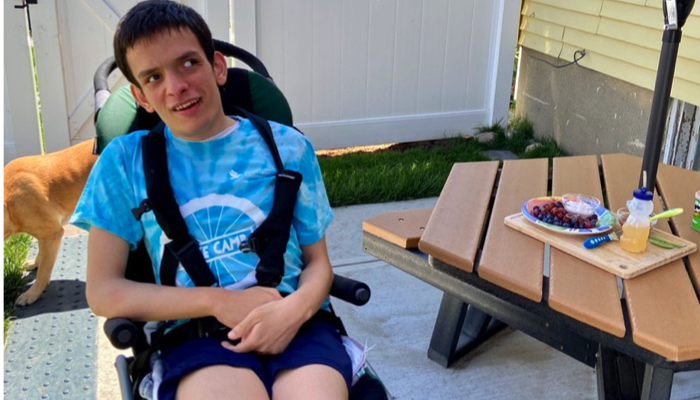
What is Adaptive Equipment?
Adaptive equipment consists of tools or devices that help people to complete their daily tasks, including moving around the house, eating, toileting, and bathing. Adaptive equipment may include modified versions of normally retailed items (e.g., staplers, scissors, tricycles, etc.) to accommodate physical or cognitive disabilities, or adaptive equipment can be devices like wheelchairs or ceiling lifts that are specifically designed to allow differently-abled individuals to be more independent (Throughout this article we will share photos of different types of adaptive equipment).
You may also see the term durable medical equipment, or DME, which refers to equipment designed to withstand heavy use and meet medical needs. Not all durable medical equipment is considered adaptive equipment, with some devices designed to treat or manage diseases rather than address functional limitations with activities of daily living (e.g., portable oxygen, continuous passive motion machines, dialysis equipment, etc.).
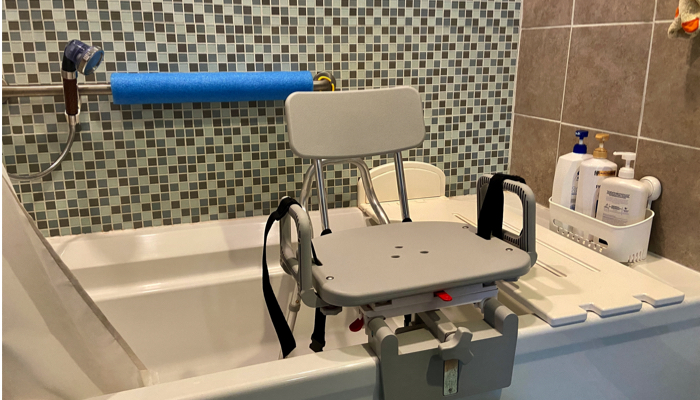
Types of Adaptive Equipment
| Equipment Type | Examples |
| Mobility Devices | Wheelchairs (manual and power) Scooters Strollers Walkers (Platform, standard, rollator) Crutches (Underarm/Axilla, Forearm/Lofstrand, Gutter) Canes |
| Lifts and Transfer Equipment | Hoyer lift Transfer boards Ceiling/Overhand Lift |
| Seating Systems | Activity Chairs Floor Sitters Feeder Seats |
| ADL Assistance | Bath and Shower Chairs Commodes Rails/Grab BarsTools (Dining Aids, Dressing Aids, Reachers, Handwriting Tools, etc.) |
| Orthotics and Prosthetics | Spinal Lower Extremity (feet, legs) Upper Extremity (hands, arms) |
| Recreational Equipment | Adaptive tricycles Sensory swings |
| Other Equipment | Communication Devices Standers Low Vision Aids Vehicle Modifications Ramps Special Needs Beds |
How Do I Obtain Adaptive Equipment for My Child?
Timeline
The process of obtaining adaptive equipment depends on a number of factors, including the complexity of the device, the need for custom modifications and measurements, and the likelihood that it will be covered by insurance. Some “off-the-shelf” devices can be purchased directly through a vendor without the need for a prescription or evaluation. Other devices (e.g., custom wheelchairs, standers, and prosthetics) may take months to obtain only after careful evaluation.
If your child already has a coordinated care team, the need for adaptive equipment may be brought to your attention by one of their providers. In other cases, you may recognize an unmet need and ask your child’s provider what types of equipment are available. In either case, the first step is to get a referral from your child’s physician for an equipment evaluation.
Evaluations for equipment may take place in a number of settings, from the home, outpatient clinic, or school to a hospital setting or specialty clinic at a children’s hospital. If your child is already receiving therapy services, an equipment evaluation can be done during one of their treatment sessions.
After the evaluation, a letter of medical necessity is written to send to the insurance company to justify the need for the equipment. This letter can be written by your child’s pediatrician, a specialist (like a neurologist or orthopedist), or by their therapist (like a physical or occupational therapist). The letter must be signed by the author and the prescribing physician. A physician must prescribe the equipment as a way of indicating medical need for the device. Any time approval for coverage is requested for a piece of equipment—even if a letter of medical necessity is not required—a prescription must be obtained.
Following submission of the letter of medical necessity and/or prescription, the waiting process begins. For complex devices, insurance approval can take 3-6 months. For simpler equipment like shoe inserts that don’t require a letter, insurance companies may approve the request within a month. Sometimes, requests are denied and approval must be sought again, with resubmission of a letter after addressing the reasons for denial.
A secondary submission for approval can require that the healthcare team meet with you again to see if your child has any additional functional needs. You may also seek supporting letters from other healthcare providers treating your child, such as a neurologist or orthopedist. Often, when equipment is denied, it’s because the insurance company does not consider the equipment necessary for your child’s diagnosis. In these cases, you can appeal by having your child’s doctor update their diagnosis or rewrite the letter to further explain why the equipment is necessary. Extra information that proves medical need will only help your case!
When the equipment is finally approved, the assistive technology professional will deliver your device and make any necessary adjustments. Your child’s therapist will then teach you and your child how to use the new piece of equipment.
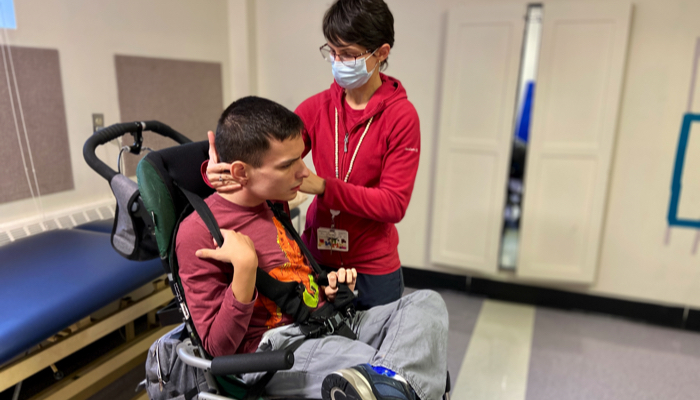
Evaluation
An adaptive equipment evaluation is a collaborative effort to determine the best option for your child. The following people may be present at an equipment evaluation:
- Patient
- Parent/Caregiver
- Physical, Occupational, and/or Speech Therapist
- Equipment Vendor/Assistive Technology Professional (ATP)
- Physician
- Nurse
The parent, caregivers, and patient provide input to the healthcare team, such as changes in medical status or history, difficulties with activities of daily living, assistance the caregiver is able to provide, pros/cons of previously used equipment, and caregiver needs. The healthcare team can suggest modifications to the equipment that may be able to improve the function, positioning, and health status of your child.
There are a number of equipment manufacturers, so determining which product best suits your child’s needs is also important. For pediatric patients, another consideration is to obtain equipment that can grow with your child (keep in mind that insurance often limits how often certain equipment can be purchased). Future needs are also essential to consider for progressive conditions like Duchenne’s Muscular Dystrophy or Spinal Muscle Atrophy, where the child’s strength and independence is expected to decrease over time.
Your child’s therapist and physician may observe important tasks related to using the equipment such as walking, standing, transferring, completing activities of daily living, and more. This will give the healthcare team further information about the abilities and safety of the patient during daily tasks.
Measurements will be taken by the therapists and assistive technology professionals so that your child will have a device custom fit to their body. These measurements may include limb length, assessment of muscle tone, height and weight, and range of motion. For orthotics and prosthetics, a cast or mold of the body area to be treated may be taken.
The fun part of the appointment for your child will be selecting a pattern or color for their new piece of equipment! The equipment vendor will share these options with you. This customization is typically offered at no additional cost and sometimes can even include embroidery on the back of a wheelchair!
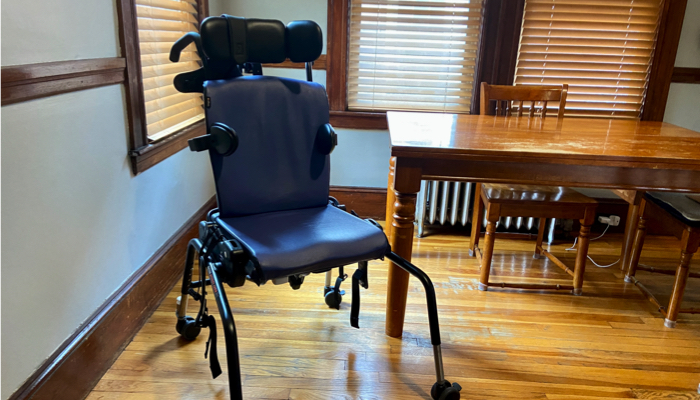
Letters of Medical Necessity
For larger and pricier pieces of adaptive equipment, a letter of medical necessity (LMN) may be required. This is typically written by the lead therapist on your child’s team of providers (occupational, speech, or physical therapist) and must be cosigned by the doctor who wrote the prescription for the device or the doctor indicated on your insurance card depending on insurance requirements. A physician, physician’s assistant, or nurse may also be the primary author of a letter of medical necessity.
Letters of medical necessity are often long documents that detail your child’s medical history, evaluation findings, specific need for the device, and justification for any custom modifications. This may also include measurements and will address functional needs at home, in the community, or at school. Due to the need to justify the need for the equipment before insurance will pay, it is important to discuss with your child’s care team any functional limitations your child has with basic mobility skills and activities of daily living.
Don’t expect an immediate turn around for this important document. Allowing at least 2-3 weeks for your child’s provider to complete a letter of medical necessity is prudent. You will want the provider to address your child’s unique situation as thoroughly and clearly as they can before submitting the letter. It is also possible for a parent or caregiver to write a letter of medical necessity, though it must be signed by your child’s treating physician.
Insurance Coverage
Adaptive equipment is often prohibitively expensive for families to purchase out of pocket. Taking the steps to seek insurance coverage is time-consuming, but can save thousands of dollars. Your coverage will vary depending on whether your child has Medicaid or private insurance.
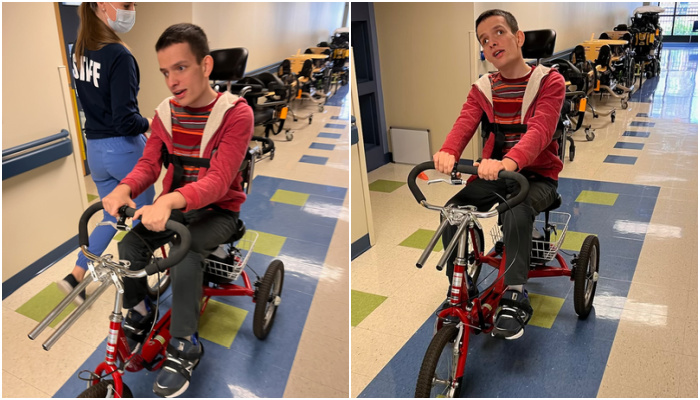
Does Insurance Cover Adaptive Equipment?
Typically, insurance will cover only items that are considered medically necessary. Durable medical equipment often falls under this requirement, but not all adaptive equipment is considered medically necessary. For example, a home modification project, vehicle modification, or adaptive tricycle are usually classified as items of convenience or recreational equipment.
Both Medicaid and private insurance companies tend to follow Medicare Part B guidelines regarding equipment coverage. That being said, each insurance company will have slightly different rules. Additionally, coverage may vary by state (Medicaid) and insurance tier (private insurance).
Some Medicaid Managed Care plans and private insurance will have copays for the evaluation. Additionally, private insurance companies are likely to have deductibles that may affect the overall coverage of a device. Since every company is different, call your insurance company before an equipment evaluation to ask what kind of coverage your child has.
For most pieces of equipment, insurance will not cover more than one of the same category of device within the same year. Often devices cannot be reordered in less than 1–3 years unless there is a significant change in medical status or growth of the child. For example, insurance will often cover either a stroller or a wheelchair, but not both since they are both items used for mobility.
Alternative Funding Sources
Since not all adaptive equipment is covered by insurance, alternative funding may be secured. Alternative funding sources have limited budgets and may only cover specific items, specific diagnoses, or patients in specific regions of the country.
Funding sources vary from state-run programs to non-profits or philanthropic efforts of established companies. A good place to start looking is local philanthropic organizations like the Lions, Kiwanis, Knights of Columbus, or Rotary Clubs. Contacting the Department of Health and Human Services in your state may also assist you in finding state-run programs beyond what traditional Medicaid offers.
Funding can be competitive since there are many children with special needs who benefit from adaptive equipment. Most funding sources have an application process that may require the submission of supporting documents (medical and/or financial in nature) to prove that your child meets their eligibility requirements. It is also important to check who must submit the application since some organizations require that the healthcare provider rather than the family submit application materials.
Beyond alternative funding sources, there are local and national durable medical equipment exchanges that allow families to borrow and use equipment free of charge.
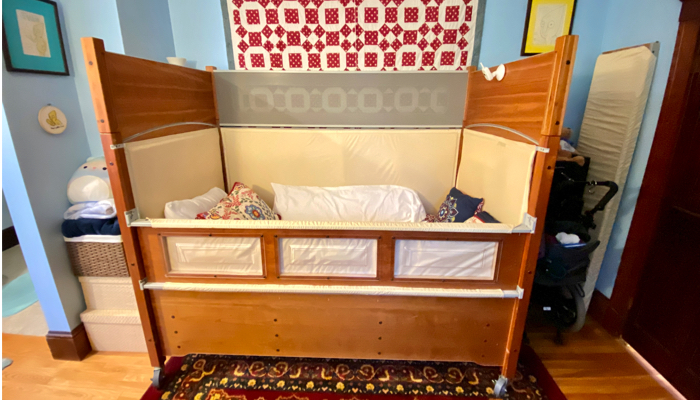
Repair and Service of Adaptive Equipment
Repair or servicing of adaptive equipment may be covered if the equipment has not exceeded its expected lifespan and if the repair requires a skilled technician. Often the vendor who provided the equipment will also complete service and repairs, either traveling to the patient’s home or healthcare office. If the child’s school therapist is involved with equipment ordering and it is appropriate to the setting, delivery, repair, and services may happen at the child’s school, though this is less common.
Insurance will typically not cover problems with normal wear and tear or basic adjustments that can be completed by a caregiver. However, if you are uncomfortable with making adjustments on your own, discuss your concerns with your child’s therapist and equipment vendor. Experienced therapists may be able to make simple adjustments during your child’s treatment sessions.
Additional Resources
Common Insurance Coverage Policies
*This information is for general use only and may not reflect all costs related to your child’s specific insurance policy. Please call your insurance company for a detailed description of your child’s coverage.
- Medicare Claims Processing Manual
- Durable Medical Equipment in Medicaid
- Blue Cross Blue Shield/Anthem: Durable Medical Equipment Policy
- UnitedHealthcare: Durable Medical Equipment
Alternative Funding Sources
- UnitedHealthcare Children’s Foundation
- H.A.L.O. Foundation
- MagicMobility
- Cerner Charitable Foundation
- Giving Angels Foundation
- Wheelchairs 4 Kids
- GoFundMe Medical Fundraising
Durable Medical Equipment Exchange
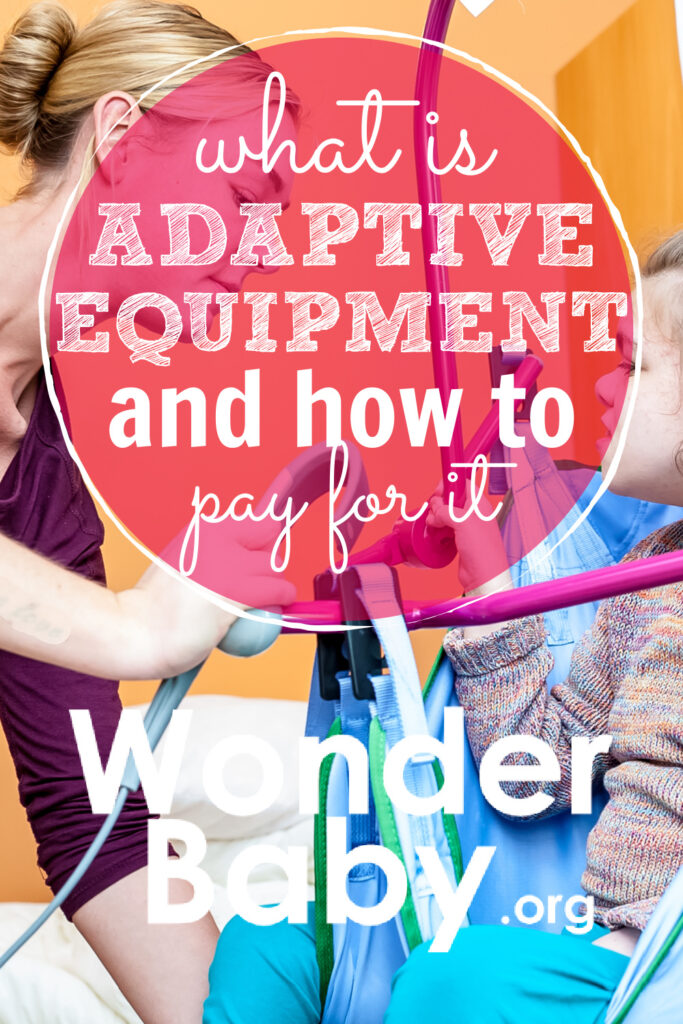
The information WonderBaby provides is not intended to be, and does not constitute, medical or other health advice or diagnosis and should not be used as such. Always consult with a qualified medical professional about your specific circumstances.
Related Posts

Eye Conditions and Syndromes, Visual Impairment
Neuralink Announces Plans to Restore Sight to the Blind with Brain Chip
Elon Musk’s company Neuralink has announced plans to begin human trials of its new “Blindsight” brain chip by the end of 2025.

Special Needs
5 Spring Cleaning Tips for Families of Children with Disabilities
Spring cleaning is an opportunity to create a more accessible, organized, and supportive space for your child with disabilities. Declutter, deep clean, and refresh!

Visual Impairment
The Gift of Understanding: How a Young Child Helps His Blind Father Navigate Life
When a parent is blind, it’s natural for people to wonder how their sighted child will adapt. Will they struggle to understand their parent’s needs? Will they feel burdened by...